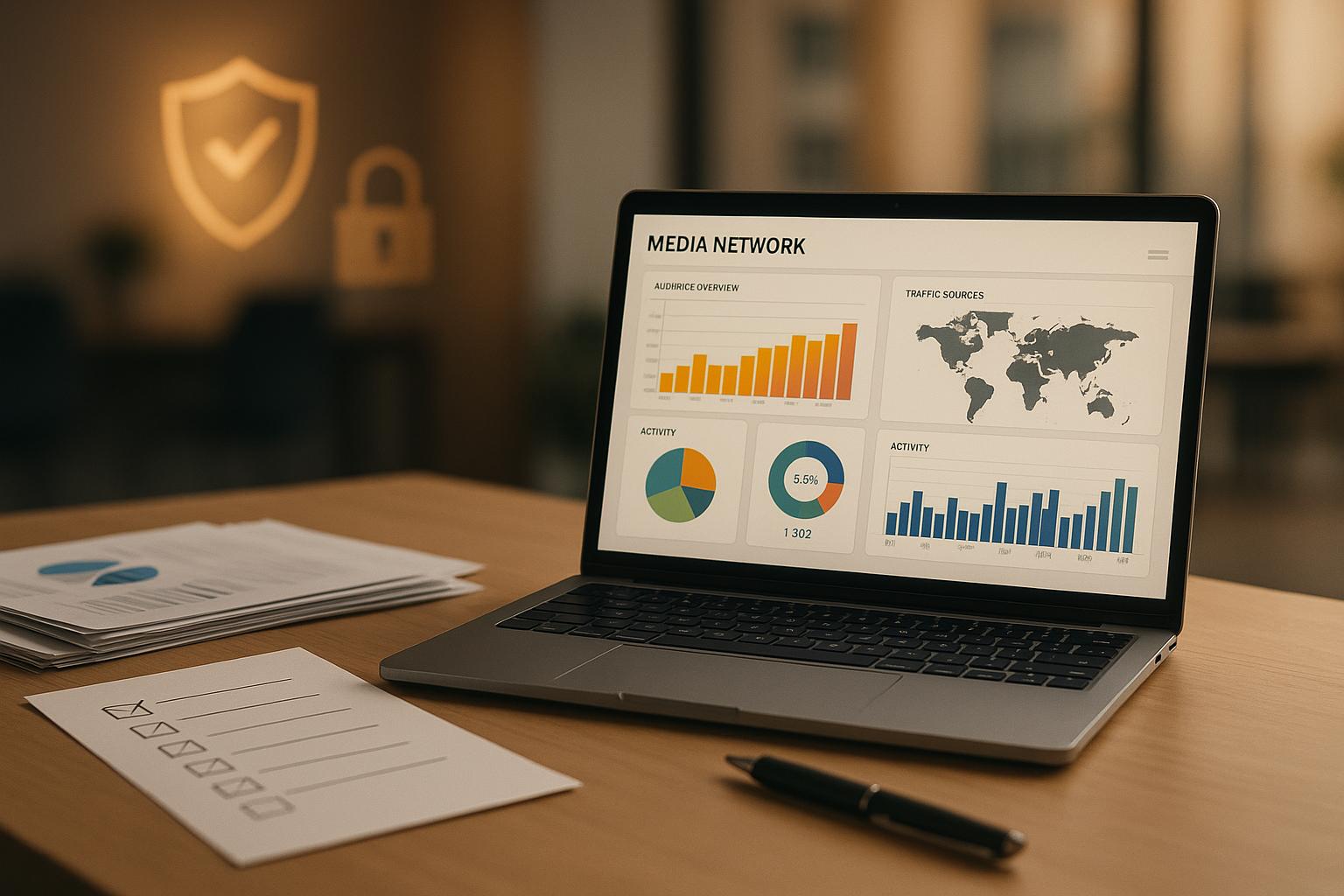B2B data monetization is transforming how businesses generate revenue from their data assets. Companies leveraging data effectively can secure loans, cut costs, and boost pricing power. Here's a quick breakdown of how to succeed:
- Choose the Right Model: Options include Data-as-a-Service (subscriptions), Insight-as-a-Service (analytics dashboards), and Data Marketplaces (commission-based platforms).
- Overcome Challenges: Address privacy laws (e.g., GDPR), improve data quality (reduce stale or duplicate records), and update technical systems (modernize APIs and encryption).
- Use Proven Methods: Blend revenue strategies, align data with customer needs, and explore new models like using data as loan collateral.
- Build a Strong Infrastructure: Invest in secure systems, AI tools, and scalable platforms to maximize efficiency and compliance.
Data monetization: Boost your product and add new revenue streams
Key Data Monetization Challenges
B2B organizations face several obstacles when trying to profit from their data assets. Recent studies highlight specific barriers that affect both revenue potential and successful implementation.
Privacy Laws and Compliance
Navigating the ever-changing regulatory landscape is no small feat. Privacy laws have become more stringent, especially with updates like the 2024 California Privacy Rights Act, which now requires explicit consent for selling B2B contact information [1]. Similarly, GDPR's Article 35 adds another layer of complexity by mandating Data Protection Impact Assessments for datasets involving EU citizens [9].
To tackle these challenges, Kyndryl introduced geo-fenced data partitioning paired with automated compliance updates. This approach led to a 37% reduction in compliance overhead [7][9].
Data Quality Problems
Poor data quality can derail monetization efforts. Research highlights key issues and their consequences:
| Quality Issue | Consequence |
|---|---|
| Stale Data (32%) | 75% drop in lead value for executive contact databases |
| Duplicate Records (19%) | Reduced trust in customer data platforms |
| Format Inconsistencies (41%) | Broken integrations in date and currency standards |
Kemira, a leader in the chemical industry, showcased the benefits of improving data quality.
"Our systematic approach to data quality management resulted in 68% faster dataset preparation, 22% higher price premiums, and 53% fewer customer disputes, achieving 3:1 ROI within 18 months" [7][9].
Technical Limitations
Technical barriers also play a major role in limiting revenue opportunities. According to CARTO's 2024 survey, enterprises lose an average of $2.3M annually due to outdated systems [8]. The most common technical challenges include:
- API limitations that prevent real-time data access [9].
- Siloed architectures that triple the time needed for data preparation [3].
- Outdated encryption methods that fail to meet marketplace requirements [1].
For example, Metso Outotec revamped its platform and cut product launch cycles from 11 months to just 3 months [7][8].
The next section will explore Proven Data Monetization Methods that address these challenges while aligning with business goals.
Proven Data Monetization Methods
Turning data into revenue in the B2B space requires smart strategies that balance profit potential with practical execution. Recent studies highlight several methods that consistently bring results.
Choosing the Right Revenue Model
New approaches, like using data as collateral for loans, allow businesses to leverage their data assets while retaining control [1]. These emerging models work alongside more established monetization strategies, creating a dynamic and evolving landscape.
Blending Revenue Strategies
Platforms today often combine multiple monetization methods to maximize income. For example, companies can:
- Set up private data storefronts while also offering anonymized datasets on public marketplaces.
- Add premium analytics services to basic data subscription packages.
PwC research underscores the impact of these hybrid strategies:
"68% of media companies implementing hybrid 'DaaP + complementary product' strategies saw revenue increases exceeding 30% within the first year of implementation" [2].
Aligning Data with Customer Needs
The key to successful data monetization lies in understanding and meeting customer demands. Revelate’s marketplace, for instance, offers customizable B2B data bundles tailored to specific industries [1]. This approach tackles the common issue of outdated data - highlighted earlier - with real-time validation.
Some effective alignment strategies include:
- Analyzing client challenges to identify pain points.
- Creating modular solutions that can be tailored to different needs.
- Integrating APIs for seamless system compatibility.
Companies often test these ideas through small-scale pilots. The best results come from solving niche industry problems rather than offering one-size-fits-all datasets [3][6].
AI-powered metadata tagging has also transformed how businesses match datasets to customer needs. This technology improves categorization and makes datasets easier to find, boosting both sales and customer satisfaction [4][10].
Implementing these methods requires the right tools and systems, which will be explored in the next section.
Required Tools and Systems
To implement these methods effectively, you need a setup that combines easy access with top-tier security. For B2B data monetization, this means having systems that safeguard data, scale with your needs, and deliver measurable outcomes.
Data Infrastructure Basics
A solid data monetization strategy starts with reliable cloud storage and processing. Many B2B companies rely on Snowflake's data processing engine for its advanced analytics and strong data management features [3].
To connect and manage these systems, tools like MuleSoft act as middleware. They help create a seamless data ecosystem that can adapt as business requirements evolve [3].
Security and Control Systems
Given the earlier challenges with compliance, modern systems now rely on zero-trust architecture for security. For example, Salesforce's 2024 model integrates role-based access (reducing breaches by 28%), AWS encryption, and multi-factor authentication (boosting security by 15%).
Additional tools like HashiCorp Vault and Okta enhance security with encrypted key management and identity controls, all while maintaining ease of use [4]. These robust measures set the stage for leveraging AI tools effectively.
AI Tools for Data Value
AI has reshaped how businesses unlock the value of their data. Tools like the B2B Ecosystem's AI Process Optimizer automate quality checks and analyze usage patterns, while Forager.ai uses predictive models for dynamic pricing based on market trends [1][5].
Key AI-driven capabilities include:
- Automated analysis of market demand
- Real-time pricing adjustments
- Revenue growth through pattern recognition [5]
sbb-itb-01010c0
Risk Management Steps
Managing risks in B2B data monetization calls for advanced controls and thorough testing. Companies must implement systems that safeguard sensitive data while ensuring it remains useful.
Access Control Layers
To meet compliance needs, a multi-layered access system is key. Combining Role-Based Access Control (RBAC) with Attribute-Based Access Control (ABAC) provides strong protection. This dual approach has shown success, significantly cutting down on unauthorized access attempts.
Here's how the system works:
| Access Layer | Purpose | Security Measure |
|---|---|---|
| Metadata Layer | Initial Assessment | Read-only preview access |
| Testing Layer | Validation | Watermarked sample datasets |
| Production Layer | Full Access | Contract-based permissions |
| Monitoring Layer | Security | Immutable audit logging |
A great example is Google Cloud Analytics Hub, which uses SCIM 2.0 for user provisioning while maintaining separate permission sets for monetization purposes [1][5]. This setup addresses a major issue: 68% of data breaches occur due to excessive privileges [4].
Test Data Generation
Modern test data systems strike a balance between security and usability. Siemens, for instance, uses digital twins to simulate equipment behavior with synthetic sensor data [3][6].
Their simulations demonstrate:
"Statistical fidelity with less than 5% variance in mean/median values across key fields while maintaining a re-identification risk below 0.01%" [4].
This process relies on three main components:
These strategies allow companies to safely explore new monetization opportunities, which we'll dive into next.
New Data Monetization Methods
With solid infrastructure and effective risk controls in place, new approaches are emerging to turn secure, high-quality data into revenue. The industry is moving quickly toward more advanced strategies that combine different revenue sources.
Data Markets vs API Services
These strategies tackle earlier issues like technical constraints and compliance risks by using standardized tools and audit trails. The current landscape is divided between marketplace platforms and API-based services, each catering to specific business needs.
| Approach | Time to Market | Scalability |
|---|---|---|
| Marketplaces | 2-4 weeks | Static datasets |
| API Services | 3-6 months | >1M daily calls |
| Hybrid Model | 4-8 weeks (customizable) | Both options |
Alternative Data Business Models
New financing and service models are changing how businesses make money from their data. For example, Gulp Data introduced the concept of using data as collateral for loans. Under this model, companies borrow money based on their data assets, and the lender deletes any data copies once the loan is repaid [1].
"E-commerce platforms leveraging transaction histories with 90+ day activity logs achieve optimal collateral value, with 87% of approved Gulp Data loans having more than 50 descriptive tags per dataset" [1].
Research from PwC shows that companies offering cleansed datasets paired with predictive tools see a 32% boost in Average Revenue Per User compared to those selling raw data [2][3].
Other emerging models include private data ecosystems with branded storefronts, bundled analytics services (insight-as-a-service), and franchise-style setups allowing third-party app development. Franchise models often feature revenue-sharing deals ranging from 15-25% [5], helping create thriving ecosystems around data assets.
Next Steps
Key Action Items
To build on the access control layers and test data generation systems discussed earlier, companies need a clear and structured plan for implementation.
Here are the steps to prioritize for the best results:
1. Audit Data Assets
Begin with a thorough metadata analysis to pinpoint high-value assets. Businesses using automated classification tools have reported 40% faster time-to-market for launching new data products [3][10].
2. Establish Technical Foundation
Set up a scalable architecture that supports rapid expansion and smooth integration of new monetization models.
Growth Opportunities
According to recent market data, companies using dynamic packaging strategies have seen a 30% increase in revenue by optimizing how they structure their offerings [3].
Key areas to focus on include:
- Flexible pricing models that adjust to usage patterns
- Clear and standardized API documentation
- Automated workflows to ensure compliance
These approaches address earlier challenges around technical limitations and compliance risks, creating a streamlined process for implementation.
To maintain growth, it’s essential to invest in team development and bring in specialized roles that drive successful monetization efforts, as highlighted in the blended revenue strategy analysis.
FAQs
How does data privacy relate to data monetization?
Data privacy and monetization are closely linked in B2B settings. In fact, 35% of organizations identify compliance as their biggest hurdle to monetizing data effectively [4]. Proper privacy management can lead to higher pricing - companies with certified compliance often achieve 15-22% higher price points, according to Datarade benchmarks [1].
Here’s how privacy measures influence monetization:
| Privacy Measure | Impact on Monetization | Implementation Example |
|---|---|---|
| Data Clean Rooms | Enables secure multi-party analysis | Harbr's platform uses dynamic watermarking to track usage while keeping data valuable [1] |
| Privacy-Enhancing Technologies (PETs) | Maintains data's commercial value | Datarade Marketplace requires GDPR certification for dataset listings [1] |
| Consent Management | Builds trust with users | Datarade Marketplace requires GDPR certification for dataset listings [1] |
New technologies like federated learning are making it possible to monetize data while adhering to strict privacy standards [11]. These solutions enhance existing systems such as access controls and test data generation methods discussed in Risk Management Steps.


